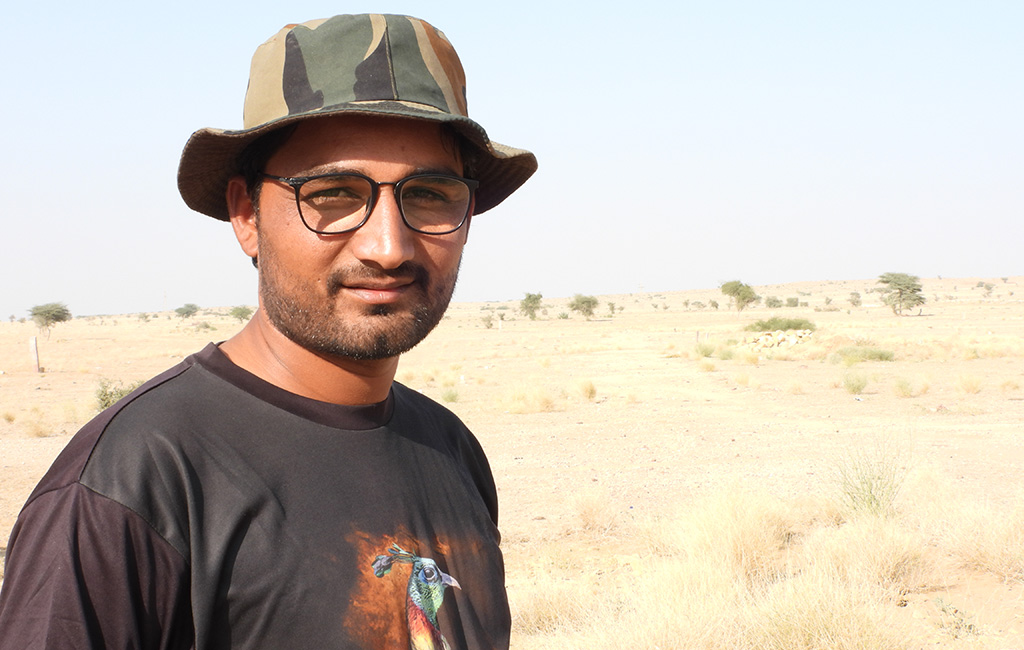
Young twitcher becomes desert’s star birding guide
With a passion for birds, birding guide Musa Khan hopes his work will inspire other twitchers to become aware of rising bird deaths due to power transmission lines in the Thar desert.

With a passion for birds, birding guide Musa Khan hopes his work will inspire other twitchers to become aware of rising bird deaths due to power transmission lines in the Thar desert.
Most Gen-Xers spend hours looking at social media.
But this 27-year-old Rajasthani is passionate about birds, preferring to be a twitcher — a birding guide — rather than spending his time on Twitter.
While most of us can’t tell the difference between the different species of larks or even pipits, which look similar beyond minor variations, Musa Khan can.
He is one of India’s youngest and most respected guides for bird watchers and scientists in India’s Desert National Park (DNP) in the Jaisalmer district of Rajasthan.
But he is on a mission too.
Khan wants people to be aware of birds being electrocuted from the rising number of power lines bringing electricity from the renewable energy plants in the Desert National Park.
Given his passion for birds, this always plays on Khan’s mind.

“When will birds stop getting killed by power transmission lines?” he asks.
By getting visitors to the park interested in birds, and creating awareness, he hopes to prevent bird mortality from power lines.
Khan always had a huge fascination for the ecological characteristics of birds, as his village, Neebha, is inside the Desert National Park.
His life took a turn in 2015 when he attended a workshop the forest department organised to train tour guides. He not only learnt a lot more about birds during the workshop, but impressed the trainers.

They told Khan that he would make a good guide for birdwatchers. Sure enough, he has turned out to be one of the best.
During winters, when the birding season is at its peak, he gets to guide around 100 birdwatcher groups.
“Musa has taken bird-watching in the Desert National Park to a higher level that will help in popularising the park,” Asad Rahmani, former director of Bombay Natural History Society (BNHS) and a prominent ornithologist, told Village Square.
“Musa can recognise more than 200 bird species. He also knows their basic ecology, behaviour, migration, movement, plumage differences – of birds in the DNP and the Thar desert,” said Rahmani. “If I need additional information on a species in DNP, I contact him.”

Khan knows the small gender differences between male and female red-headed vultures (Sarcogyps calvus), or the subtle plumage, vocal and behavioural variations in 10 different lark and 10 different pipit species that are found in DNP.
“Larks and pipits are difficult birds to identify as many species look similar with extremely minute variations. For example, you need an expert’s eye to identify a juvenile paddy field pipit (Anthus rufulus) from the juvenile of a tawny pipit (Anthus campestris). Even I get confused with my 45 years of bird-watching experience, but Musa Khan has developed the skill to recognise them,” Rahmani said.
Khan’s knowledge of birds at DNP is something that visitors enjoy. Especially the features of different birds and their behaviour in different seasons. For example, he easily noticed that the tawny eagle (Aquila rapax) loses weight in winter after the breeding season. Rahmani corroborated saying that it happens because of the long breeding season of the bird.
With his passion for birds, it is little wonder that he is concerned about the threats that birds face. He is especially worried about the bird mortality in DNP due to power transmission lines.

“I heard that the Supreme Court has asked the government to do something about it. But nothing has happened so far. The birds are still dying. I hope the government does the needful,” Khan said.
The Supreme Court had issued an order (in response to a public interest litigation) on April 09, 2021. It directed the government to lay the power lines from renewable energy plants underground, rather than above. Especially in potential habitats of critically endangered birds in Rajasthan and Gujarat – the states with a number of solar and wind parks.
The Supreme Court order had cited a report by the Wildlife Institute of India (WII) noting “surveys conducted by Wildlife Institute of India in Thar [Desert] covering 80 km of power lines repeated seven times over a year found 289 carcasses of around 40 species, including the Great Indian Bustard.”
The latest study by WII scientists has estimated 87,966 bird mortalities a year due to power lines in their study area spanning over 4,200 km2 in Thar Desert in Jaisalmer.
So the scientists called for immediate mitigation measures to stop bird mortality due to power lines in the Thar Desert.

But Khan said that so far nothing has changed on the ground as regards the bird mortality.
“I keep discovering carcasses of birds killed by power lines,” he said. “When I see a carcass, I feel very bad. This should not happen to the birds.”
Khan has now become the most sought-after birding guide for ornithologists and bird lovers. He is also the go-to man for forest department officials when they organise wildlife conservation awareness programmes for the villagers.
“I like Musa Khan because he is a self-made man. He is not only a good birdwatcher but also a good human being. He takes good care of his birdwatcher clients. And most importantly, he loves birds and tries to keep a safe distance so as not to disturb their normal activities,” said Rahmani. “Musa Khan is the “birding star” of Desert National Park.”
“Khan is a sort of an ambassador for all birds. Not only the Great Indian Bustard, but all birds are important,” he told Village Square.
Athar Parvaiz is a Srinagar-based journalist.